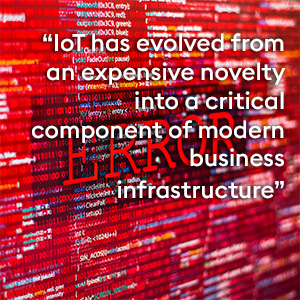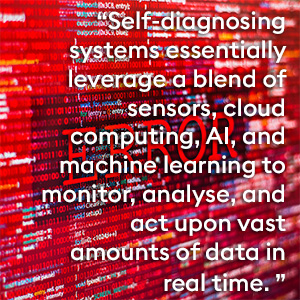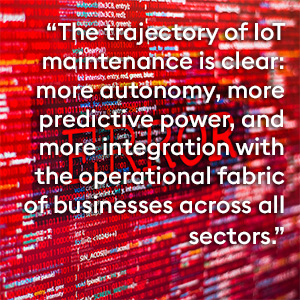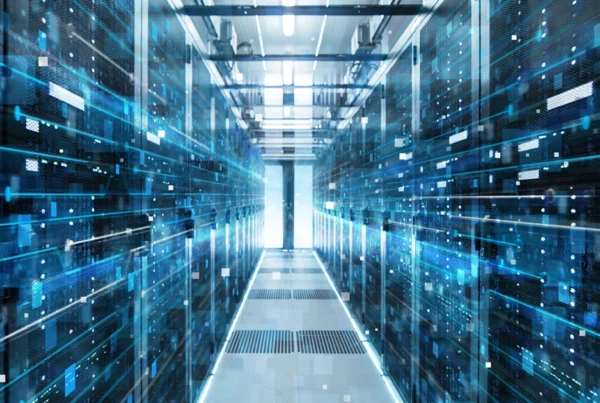Making Operational Interruptions a Thing of the Past: The Power of IoT Self-Diagnosis
Imagine a scenario where critical systems predict and rectify their own faults before they have a chance to impact your business operations.
Downtime is a dirty word. For most businesses it’s not an option due to the significant costs, both financial and reputational. Many within the managed IT services world have therefore spent years pioneering the integration of self-diagnosing systems with the aim of fortifying critical business operations against the threat of unforeseen disruptions. The goal is to create systems that will work harder to ensure that operational interruptions are closer to being a thing of the past.
This article investigates how this transformative technology is setting a new standard for operational excellence, promising a future where efficiency, reliability, and continuity are not aspirational but assured.
The Emergence of Self-Diagnosing IoT Systems
The concept of the Internet of Things (IoT) was first coined by Kevin Ashton in 1999, yet its roots can be traced back to the early 1980s with the invention of Internet-connected appliances and early home automation systems. As sustainability within the business environment grew in importance, a need arose for new solutions that connected motion and thermal sensors to lighting, heating or ventilation systems to ensure a lower cost, more environmentally friendly use of these utilities. All of these are examples of IoT in action.
 Fast-forward a couple of decades, and IoT has evolved from an expensive novelty into a critical component of modern business infrastructure, offering unprecedented control and monitoring capabilities. Self-diagnosing IoT systems represent the next evolutionary leap in this technology, often merging artificial intelligence (AI) and machine learning with connectivity to not only report when things go awry, but also to predict future issues and solve problems autonomously.
Fast-forward a couple of decades, and IoT has evolved from an expensive novelty into a critical component of modern business infrastructure, offering unprecedented control and monitoring capabilities. Self-diagnosing IoT systems represent the next evolutionary leap in this technology, often merging artificial intelligence (AI) and machine learning with connectivity to not only report when things go awry, but also to predict future issues and solve problems autonomously.
When you have systems interconnecting with one another to achieve either a single complex task or a multitude of them, you have the opportunity to incorporate sophisticated monitoring technologies to more precisely and rapidly identify trigger points and issues in the making, so they can be resolved before any significant damage is done.
Key Components of Self-Diagnosing IoT Systems
 Self-diagnosing systems essentially leverage a blend of sensors, cloud computing, AI, and machine learning to monitor, analyse, and act upon vast amounts of data in real time. For managed IT services providers, these technologies provide access to advanced predictive maintenance, ensuring businesses can pre-empt potential issues without the need for deep in-house technical expertise. The sophistication of these technologies often means that specialist help is needed for installing, maintaining and optimising their use. And the data these systems produce, offering a predictive analysis of the potential for future issues, still requires some interpretation – a managed IT services expert with digital linguistic skills.
Self-diagnosing systems essentially leverage a blend of sensors, cloud computing, AI, and machine learning to monitor, analyse, and act upon vast amounts of data in real time. For managed IT services providers, these technologies provide access to advanced predictive maintenance, ensuring businesses can pre-empt potential issues without the need for deep in-house technical expertise. The sophistication of these technologies often means that specialist help is needed for installing, maintaining and optimising their use. And the data these systems produce, offering a predictive analysis of the potential for future issues, still requires some interpretation – a managed IT services expert with digital linguistic skills.
The Distinct Benefits of Self-Diagnosing Systems
Self-diagnosing systems mark a significant leap forward in technological innovation, offering benefits to a broad spectrum of businesses. These intelligent systems are designed to monitor, analyse, repair and report on the health and performance of a wide variety of devices and infrastructures in real time. From healthcare and smart cities to agriculture and energy management, the implementation of self-diagnosing systems is revolutionising efficiency, enhancing safety, and driving sustainability.
Here are a few of the myriad of benefits that self-diagnosing systems offer:
- Reduced Downtime: I may have already mentioned this once or twice, but its level of importance necessitates repetition. Self-diagnosing IoT systems are capable of automatic detection and correction of issues before they cause system failures.
- Cost Efficiency: Maintenance expenses are reduced through predicting failures before they even have a chance to happen, snuffing out the potential fire before it has a chance to spark into life.
- Operational Reliability: Ensures smoother business operations, greater predictability and reliability, resulting in greater trust and confidence from staff and customers.
- Data-Driven Insights: The data collected and analysed by these systems offers valuable insights into system performance, which in turn can aid any organisation to improve its strategic decision-making.
- Scalability: Self-diagnosing IoT systems can be easily integrated into an organisation’s existing infrastructure, growing with your business needs.
Implementation Challenges and Solutions
 This is not a ‘plug and play’ situation. The integration of self-diagnosing technology within existing or even legacy systems poses challenges. Skilled people will be needed for the initial setup and to manage and interpret the data produced, so you might want to speak with your managed IT service providers. They are likely to play a crucial role in navigating these hurdles, providing the expertise and support your business needs to leverage this technology effectively.
This is not a ‘plug and play’ situation. The integration of self-diagnosing technology within existing or even legacy systems poses challenges. Skilled people will be needed for the initial setup and to manage and interpret the data produced, so you might want to speak with your managed IT service providers. They are likely to play a crucial role in navigating these hurdles, providing the expertise and support your business needs to leverage this technology effectively.
Real-World Application
This may seem quite academic, so I thought I’d include a few real-world applications and success stories of self-diagnosing IoT systems to stand as testaments to their transformative power.
- Manufacturing: A great example of the benefits of IoT systems within the manufacturing sector are the automotive manufacturers who have implemented self-diagnosing sensors into their assembly lines. For some this has resulted in a 30% reduction in unplanned downtime and up to a 25% decrease in maintenance costs.
- Healthcare: An example within healthcare would be a hospital network that adopted IoT self-diagnosing systems for its medical equipment, which improved equipment uptime by somewhere in the region of 20%, enhancing patient care through more reliable diagnostic tools.
- Smart Cities: Incorporating IoT into city management has transformed traffic management, air pollution control, and disaster management. Smart parking systems, like Parker, guide drivers to available spaces in real time, significantly reducing traffic congestion and enhancing urban mobility.
- Agriculture: IoT technologies are making farming more efficient and sustainable. Smart irrigation systems and sensors provide data on soil conditions, enabling optimised crop growth. The global smart farming market is projected to reach nearly $30 billion this year, demonstrating the significant impact of IoT on agricultural productivity and environmental sustainability.
- Energy Sector: IoT is driving efficiency in energy management through smart grids and meters. Utility services analyse real-time data to manage energy distribution effectively, addressing blackouts and adapting to demand fluctuations. The potential annual benefits to the energy sector could reach $40-70 billion by 2025.
The Future is Self-Aware
 The trajectory of IoT maintenance is clear: more autonomy, more predictive power, and more integration with the operational fabric of businesses across all sectors. The future looks bright for self-diagnosing IoT systems and promises to rapidly evolve beyond merely identifying and rectifying issues to a form that also involves self-adaptation and growth based on predictive data. There will always be an appetite for solutions that make life easier for businesses and that protect the integrity and continuity of the services provided by these systems.
The trajectory of IoT maintenance is clear: more autonomy, more predictive power, and more integration with the operational fabric of businesses across all sectors. The future looks bright for self-diagnosing IoT systems and promises to rapidly evolve beyond merely identifying and rectifying issues to a form that also involves self-adaptation and growth based on predictive data. There will always be an appetite for solutions that make life easier for businesses and that protect the integrity and continuity of the services provided by these systems.
The integration of self-diagnosing systems within IoT marks a pivotal shift towards more resilient, efficient, and intelligent operations. Don’t get left behind – any decent managed IT services firm should be able to offer you guidance on how these innovations could help you to keep pace with your competition, a crucial factor in a world where reliability is often the most important differentiator.
For more information on Managed IT Services London contact Assembly Managed Services.
Telephone: +44 (0)20 3795 6880
Have you enjoyed this blog? If so, why not share it on your preferred social media platform?






